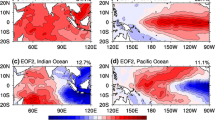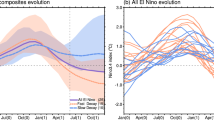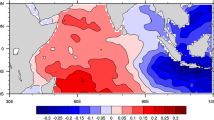Abstract
The persistence of the Indian Ocean Basin Mode (IOBM) from March to August is important for the prediction of Asian summer monsoon. Based on the observational data and the pre-industrial control run outputs of the Community Climate System Model, version 4 (CCSM4), the IOBM is categorized into three types: the first type can persist until August; the second type transforms from the positive (negative) IOBM into the negative (positive) Indian Ocean Dipole Mode (IODM), accompanied by the El Niño-to-La Niña (La Niña-to-El Niño) transition in the boreal summer; the third type transforms from the positive (negative) IOBM into the positive (negative) IODM in early summer. It is discovered that aside from the influence of anomalous Walker Circulation resulted from the phase transition of ENSO, the persistence of Australia high anomaly (AHA) over the southeastern tropical Indian Ocean (TIO) and the west of Australia from March to May is favorable for the positive (negative) IOBM transformation into the positive (negative) IODM in the boreal summer. The stronger equatorially asymmetric sea surface temperature anomalies (SSTAs) in the boreal spring are the main mechanism for the persistence of IOBM, because the asymmetric atmospheric responses to the stronger equatorially asymmetric SSTAs in the TIO confine the AHA to the east of Australia from May to August. This result indicates a possibility of predicting summer atmospheric circulation based on the equatorial symmetry of SSTAs in the TIO in spring.







Similar content being viewed by others
References
Alexander MA, Blade I, Newman M, Lanzante JR, Lau NC, Scott JD (2002) The atmospheric bridge: the influence of ENSO teleconnections on air–sea interaction over the global oceans. J Clim 15(16):2205–2231. doi:10.1175/1520-0442(2002)015<2205:tabtio>2.0.co;2
Behera SK, Yamagata T (2001) Subtropical SST dipole events in the southern Indian Ocean. Geophys Res Lett 28:327–330
Behera SK, Krishnan R, Yamagata T (1999) Unusual ocean atmosphere conditions in the tropical Indian Ocean during 1994. Geophys Res Lett 26:3001–3004. doi:10.1029/1999GL010434
Behera SK, Luo JJ, Masson S, Rao SA, Sakuma H, Yamagata T (2006) A CGCM study on the interaction between IOD and ENSO. J Clim 19:1688–1705. doi:10.1175/JCLI3797.1
Bjerknes J (1969) Atmospheric teleconnections from the equatorial Pacific. Mon Weather Rev 97:163–172
Boschat G, Terray P, Masson S (2011) Interannual relationships between Indian summer monsoon and Indo-Pacific coupled modes of variability during recent decades. Clim Dyn 37:1019–1043. doi:10.1007/s00382-010-0887-y.
Cai W, Rensch P van, Cowan T, Hendon HH (2011) Teleconnection pathways of ENSO and the IOD and the mechanisms for impacts on Australian rainfall. J Clim 24:3910–3923. doi:10.1175/2011JCLI4129.1
Chang CP, Li T (2000) A theory of the tropical tropospheric biennial oscillation. J Atmos Sci 57:2209–2224
Chiang JCH, Lintner BR (2005) Mechanisms of remote tropical surface warming during El Niño. J Clim 18:4130–4149. doi:10.1175/jcli3529.1
Chiang JCH, Sobel AH (2002) Tropical tropospheric temperature variations caused by ENSO and their influence on the remote tropical climate. J Clim 15:2616–2631. doi:10.1175/1520-0442(2002)015<2616:tttvcb>2.0.co;2
Chowdary JS, Xie SP, Luo JJ, Hafner J, Behera S, MasumotoY, Yamagata Y (2011) Predictability of Northwest Pacific climate during summer and the role of the tropical Indian Ocean. Clim Dyn 36(3): 607–621. doi:10.1007/s00382-009-0686-5.
Chowdary JS, et al. (2016) Indian summer monsoon rainfall variability in response to differences in the decay phase of El Niño. Clim Dyn. doi:10.1007/s00382-016-3233-1
Deser C, Phillips AS, Tomas RA, Okumura YM, Alexander MA, Capotondi A, Scott JD, KwonYoung-Oh, Ohba M (2012) ENSO and Pacific decadal variability in the community climate system model version 4. J Clim 25:2622–2651. doi:10.1175/JCLI-D-11-00301.1
Du Y, Xie SP, Huang G, Hu KM (2009) Role of air–sea interaction in the long persistence of El Niño-induced north Indian Ocean warming. J Clim 22(8):2023–2038. doi:10.1175/2008JCLI2590.1
Du Y, Cai W, Wu Y (2013a) A new type of the Indian Ocean dipole since the mid-1970s. J Clim 26:959–972. doi:10.1175/JCLI-D-12-00047.1
Du Y, Xie SP, Yang YL, Zheng XT, Liu L, Huang G (2013b) Indian Ocean variability in the CMIP5 multi model ensemble: the basin mode. J Clim 26(18):7240–7266. doi:10.1175/JCLI-D-12-00678.1
Gill AE (1980) Some simple solutions for heat-induced tropical circulation. Q J R Meteorol Soc 106:447–462. doi:10.1002/qj.49710644905
Guo FY, Liu QY, Zheng XT, Sun S (2013) The role of barrier layer in southeastern Arabian Sea during the development of positive Indian Ocean dipole events. J Ocean Univ China 12(2):245–252. doi:10.1007/s11802-013-2170-4
Guo FY, Liu QY, Sun S, Yang JL (2015) Three types of Indian Ocean dipoles. J Clim 28:3073–3092. doi:10.1175/JCLI-D-14-00507.1
Hong XY, Hu HB, Yang XQ, Zhang Y, Liu GQ, Liu W (2014) Influences of Indian Ocean interannual variability on different stages of El Niño: a FOAM1.5 model approach. Sci China Earth Sci 57: 2616–2627. doi:10.1007/s11430-014-4932-2.
Huang B, Kinter JL III (2002) Interannual variability in the tropical Indian Ocean. J Geophys Res 107:3199. doi:10.1029/2001JC001278
Huang G, Hu KM, Xie SP (2010) Strengthening of tropical Indian Ocean teleconnection to the Northwest Pacific since the mid-1970s: an atmospheric GCM study. J Clim 23(19):5294–5304. doi:10.1175/2010jcli3577.1
Huang G, Qu X, Hu KM (2011) The impact of the tropical Indian Ocean on South Asian high in Boreal summer. Adv Atmos Sci 28(2): 421–432. doi:10.1007/s00376-010-9224-y.
Kalnay E, Kanamitsu M, Kistler R et al (1996) The NCEP/NCAR 40-year reanalysis project. Bull Am Meteorol Soc 77:437–471. doi:10.1175/1520-0477(1996)077<0437:TNYRP>2.0.CO;2
Klein SA, Soden BJ, Lau NC (1999) Remote sea surface temperature variations during ENSO: evidence for a tropical atmospheric bridge. J Clim 12(4):917–932. doi:10.1175/1520-0442(1999)012<0917:rsstvd>2.0.co;2
Kosaka Y, Xie SP, Nakamura H (2011) Dynamics of interannual variability in summer precipitation over East Asia. J Clim 24:5435–5453. doi:10.1175/2011JCLI4099.1
Lau NC, Nath MJ (1996) The role of the “atmospheric bridge” in linking tropical Pacific ENSO events to extratropical SST anomalies. J Clim 9:2036–2057. doi:10.1175/1520-0442(1996)009<2036:TROTBI>2.0.CO;2
Li G, Xie SP (2014) Tropical biases in CMIP5 multimodel ensemble: The excessive equatorial Pacific cold tongue and double ITCZ problems. J Clim 27:1765–1780. doi:10.1175/JCLI-D-13-00337.1
Li T, Zhang Y (2002) Processes that determine the quasi biennial and lower-frequency variability of the South Asian monsoon. J Meteorol Soc Jpn 80(5):1149–1163. doi:10.2151/jmsj.80.1149
Li T, Zhang Y, Chang CP, Wang B (2001) On the relationship between Indian Ocean SST and Asian summer monsoon. Geophys Res Lett 28:2843–2846. doi:10.1029/2000GL011847
Li G, Xie SP, Du Y (2015a) Monsoon-induced biases of climate models over the tropical Indian Ocean with implications for regional climate projection. J Clim 28:3058–3072. doi:10.1175/JCLI-D-14-00740.1
Li G, Xie SP, Du Y (2015b) Climate model errors over the South Indian Ocean thermocline dome and their effect on the basin mode of interannual variability. J Clim 28:3093–3098. doi:10.1175/jcli-d-14-00810.1
Li G, Xie SP, Du Y (2016) A robust but spurious pattern of climate change in model projections over the tropical Indian Ocean. J Clim 29:5589–5608. doi:10.1175/JCLI-D-15-0565.1
Liu QY, Guo FY, Zheng XT (2013) Relationships of interannual variability between the equatorial pacific and tropical Indian Ocean in 17 CMIP5 models. J Ocean Univ China 12(2):237–244. doi:10.1007/s11802-013-2195-8
Masumoto Y, Meyers G (1998) Forced Rossby waves in the southern tropical Indian Ocean. J Geophys Res 103(C12):27589–27602. doi:10.1029/98JC02546
Matsuno T (1966) Quasi-geostrophic motions in the equatorial area. J Meteorol Soc Jpn 44:25–43
Murtugudde RG, McCreary JP, Busalacchi AJ (2000) Oceanic processes associated with anomalous events in the Indian Ocean with relevance to 1997–1998. J Geophys Res 105:3295–3306. doi:10.1029/1999JC900294
Qu X, Huang G (2012a) Impacts of tropical Indian Ocean SST on the meridional displacement of East Asian jet in boreal summer. Int J Climatol 32(13):2073–2080. doi:10.1002/joc.2378
Qu X, Huang G (2012b) An enhanced influence of tropical Indian Ocean on the South Asia high after the late 1970s. J Clim 25(20):6930–6941. doi:10.1175/jcli-d-11-00696.1
Ramusson EM, Carpenter TH (1982) Variations in tropical sea surface temperature and surface wind fields associated with the Southern Oscillation/El Niño. Mon Weather Rev 110:354–384. doi:10.1175/1520-0493(1982)110<0354:VITSST>2.0.CO;2
Saji NH, Yamagata T (2003) Structure of SST and surface wind variability during Indian Ocean dipole mode events: COADS observations. J Clim 16:2735–2751. doi:10.1175/1520-0442(2003)016<2735:SOSASW>2.0.CO;2
Saji NH, Goswami BN, Vinayachandran PN, Yamagata T (1999) A dipole mode in the tropical Indian Ocean. Nature 401(6751):360–363. doi:10.1038/43855
Saji NH, Xie SP, Yamagata T (2006) Tropical Indian Ocean variability in the IPCC twentieth-century climate simulations. J Clim 19(17):4397–4417. doi:10.1175/jcli3847.1
Shinoda T, Alexander MA, Hendon HH (2004) Remote response of the Indian Ocean to interannual SST variations in the tropical Pacific. J Clim 17:362–372. doi:10.1175/1520-0442(2004)017<0362:RROTIO>2.0.CO;2
Smith TM, Reynolds RW, Peterson TC, Lawrimore J (2008) Improvements to NOAA’s historical merged land–ocean surface temperature analysis (1880–2006). J Clim 21:2283–2296. doi:10.1175/2007JCLI2100.1
Vinayachandran PN, Saji NH, Yamagata T (1999) Response of the equatorial Indian Ocean to an unusual wind event during 1994. Geophys Res Lett 26(11):1613–1616
Wu RG, Kirtman BP, Krishnamurthy V (2008) An asymmetric mode of tropical Indian Ocean rainfall variability in boreal spring. J Geophys Res 113(D5):D05104. doi:10.1029/2007JD009316
Wu B, Li T, Zhou TJ (2010) Relative contributions of the Indian Ocean and local SST anomalies to the maintenance of the western North Pacific anomalous anticyclone during the El Niño decaying summer. J Clim 23:2974–2986. doi:10.1175/2010JCLI3300.1
Xie SP, Annamalai H, Schott FA, McCreary JP (2002) Structure and mechanisms of south Indian Ocean climate variability. J Clim 15:867–878. doi:10.1175/1520-0442(2002)015<0864:SAMOSI>2.0.CO;2
Xie SP, Hu KM, Hafner J, Tokinaga H, Du Y, Huang G, Sampe T (2009) Indian Ocean capacitor effect on Indo-western Pacific climate during the summer following El Niño. J Clim 22:730–747. doi:10.1175/2008JCLI2544.1
Xie SP, Du Y, Huang G, Zheng XT, Tokinaga H, Hu KM, Liu QY (2010) Decadal shift in El Niño influences on Indo-Western Pacific and East Asian climate in the 1970s. J Clim 23:3352–3368. doi:10.1175/2010jcli3429.1
Xie SP, Yu K, Du Y, Hu KM, Chowdary JS, Huang G (2016) Indo-western Pacific ocean capacitor and coherent climate anomalies in post-ENSO summer: a review. Ads Adv Atmos Sci 33(4): 411–432. doi:10.1007/s00376-015-5192-6.
Yang JL, Liu QY, Xie SP, Liu ZY, Wu L (2007) Impact of the Indian Ocean SST basin mode on the Asian summer monsoon. Geophys Res Lett 34:L02708. doi:10.1029/2006GL028571
Yang JL, Liu QY, Liu ZY, Wu L, Huang F (2009) Basin mode of Indian Ocean sea surface temperature and Northern Hemisphere circum global teleconnection. Geophys Res Lett 36:L19705. doi:10.1029/2009GL039559
Yoo SH, Yang S, Ho CH (2006) Variability of the Indian Ocean sea surface temperature and its impacts on Asian–Australian monsoon climate. J Geophys Res 111:D03108. doi:10.1029/2005JD006001
Zheng XT, Xie SP, Liu QY (2011) Response of the Indian Ocean basin mode and its capacitor effect to global warming. J Clim 24:6146–6164. doi:10.1175/2011jcli4169.1
Acknowledgements
We acknowledge the World Climate Research Programme’s Working Group on Coupled Modeling. We thank the climate modeling groups for producing and making their model outputs available. We also thank the NCEP Reanalysis data provided by the NOAA/OAR/ESRL PSD, Boulder, Colorado, USA. We appreciate Prof. Yu’s technical editing. We thank the anonymous reviewers for their constructive comments and suggestions. This work is supported by the National Basic Research Program of China (2012CB955603), the Natural Science Foundation of China (41406001, 41476003 and 41490641), the China Meteorological Public Welfare Scientific Research Project (GYHY201306027 and GYHY201506001), and Shandong Joint Fund for Marine Science Research Centers (Grant No. U1406401).
Author information
Authors and Affiliations
Corresponding author
Additional information
This paper is a contribution to the special issue on East Asian Climate under global warming: understanding and projection, consisting of papers from the East Asian Climate (EAC) community and the 13th EAC International Workshop in Beijing, China on 24–25 March 2016, and coordinated by Jianping Li, Huang-Hsiung Hsu, Wei-Chyung Wang, Kyung-Ja Ha, Tim Li, and Akio Kitoh.
Rights and permissions
About this article
Cite this article
Guo, F., Liu, Q., Yang, J. et al. Three types of Indian Ocean Basin modes. Clim Dyn 51, 4357–4370 (2018). https://doi.org/10.1007/s00382-017-3676-z
Received:
Accepted:
Published:
Issue Date:
DOI: https://doi.org/10.1007/s00382-017-3676-z




